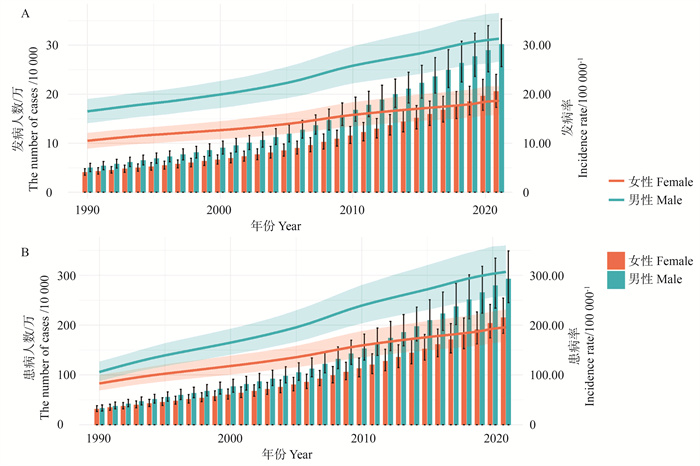-
摘要:
目的 分析中国帕金森病(Parkinson′s disease, PD)流行状况及发病趋势,为制定PD防控政策提供科学依据。 方法 采用年龄-时期-队列(age-period-cohort, APC)模型,对1990―2021年中国PD患病率及发病率进行分析,评估不同年龄、时间段及出生队列对PD流行趋势的影响。通过差分自回归移动平均(autoregressive integrated moving average, ARIMA)模型,对2024―2030年PD发病率进行预测。 结果 1990―2021年,中国PD年龄标准化发病率由12.8/10万上升至24.3/10万(P<0.001),死亡率则从6.80/10万下降至5.03/10万(P<0.001)。PD在≥30岁人群中发病率迅速升高,70~<75岁年龄组发病人数最多(81 945人)。基于ARIMA模型预测,到2030年,全国PD发病率预计将上升至26.52/10万(95% CI:24.73/10万~28.31/10万),其中男性为35.20/10万(95% CI:33.20/10万~37.21/10万),女性为20.96/10万(95% CI:20.27/10万~21.65/10万)。 结论 中国PD疾病负担加剧,发病人群以老年人为主,且存在性别差异。预测未来PD发病率仍呈上升趋势,需进一步加强PD的早期诊断、预防和管理,以减轻公共卫生负担。 -
关键词:
- 帕金森病 /
- 疾病负担 /
- 流行趋势 /
- 年龄-时期-队列模型
Abstract:Objective This study aims to investigate the prevalence and incidence trends of Parkinson′s disease (PD) in China to provide scientific evidence for developing PD prevention and control policies. Methods The age-period-cohort (APC) model was used to analyze the prevalence and incidence of PD in China from 1990 to 2021, assessing the impact of different age groups, time periods, and birth cohorts on the trends of PD. The autoregressive integrated moving average (ARIMA) model was employed to predict the PD incidence from 2024 to 2030. Results From 1990 to 2021, the age-standardized incidence rate of PD in China increased from 12.8 per 100 000 to 24.3 per 100 000 (P < 0.001), while the mortality rate decreased from 6.80 per 100 000 to 5.03 per 100 000 (P < 0.001). The incidence rate of PD rapidly increased among individuals aged 30 and above, with the highest number of cases observed in the 70- < 75 age group, reaching 81 945 cases. Based on the ARIMA model, it is predicted that by 2030, the national incidence rate of PD will rise to 26.52 per 100 000 (95% CI: 24.73/100 000-28.31/100 000), with the rate for men at 35.20 per 100 000 (95% CI: 33.20/100 000-37.21/100 000) and for women at 20.96 per 100 000 (95% CI: 20.27/100 000-21.65/100 000). Conclusions China′s PD burden is worsening, predominantly affecting the elderly, with observed gender differences. The incidence of PD is expected to continue rising in the future, necessitating further strengthening of early diagnosis, prevention, and management of PD to reduce its public health burden. -
Key words:
- Parkinson′s disease /
- Disease burden /
- Epidemiological trends /
- Age-period-cohort model
-
图 2 不同年龄组帕金森病发病与患病情况的队列趋势
A:不同年龄组帕金森病发病情况的队列趋势;B:不同年龄组帕金森病患病情况的队列趋势。
Figure 2. Cohort trends of incidence and prevalence of Parkinson′s disease across different age groups
A: cohort trends of incidence of Parkinson′s disease across different age groups; B: cohort trends in prevalence of Parkinson′s disease across different age groups.
表 1 2024―2030年中国帕金森病发病情况预测值
Table 1. Predicted incidence of Parkinson′s disease in China, 2024-2030
年份
Year全人群Total population/100 000-1 男性Male/100 000-1 女性Female/100 000-1 预测值Prediction 95% CI 预测值Prediction 95% CI 预测值Prediction 95% CI 2024 25.07 24.67~25.46 32.57 32.15~32.98 19.40 19.08~19.72 2025 25.31 24.73~25.89 33.06 32.39~33.73 19.66 19.26~20.06 2026 25.55 24.76~26.34 33.53 32.59~34.47 19.92 19.44~20.39 2027 25.79 24.78~26.80 33.97 32.77~35.18 20.18 19.64~20.71 2028 26.03 24.78~27.29 34.39 32.92~35.85 20.44 19.85~21.03 2029 26.27 24.76~27.79 34.79 33.06~36.52 20.70 20.05~21.34 2030 26.52 24.73~28.31 35.20 33.20~37.21 20.96 20.27~21.65 -
[1] Mitchell AK, Bliss RR, Church FC. Exercise, neuroprotective exerkines, and Parkinson's disease: a narrative review[J]. Biomolecules, 2024, 14(10): 1241. DOI: 10.3390/biom14101241. [2] Popescu BO, Batzu L, Ruiz PJG, et al. Neuroplasticity in Parkinson's disease[J]. J Neural Transm, 2024, 131(11): 1329-1339. DOI: 10.1007/s00702-024-02813-y. [3] Manfredsson FP, Tansey MG, Golde TE. Challenges in passive immunization strategies to treat parkinson disease[J]. JAMA Neurol, 2018, 75(10): 1180-1181. DOI: 10.1001/jamaneurol.2018.0346. [4] Group G2NDC. Global, regional, and national burden of neurological disorders during 1990-2015: a systematic analysis for the global burden of disease study 2015[J]. Lancet Neurol, 2017, 16(11): 877-897. DOI: 10.1016/S1474-4422(17)30299-5. [5] Maas BR, Göttgens I, Tijsse Klasen HPS, et al. Age and gender differences in non-motor symptoms in people with Parkinson's disease[J]. Front Neurol, 2024, 15: 1339716. DOI: 10.3389/fneur.2024.1339716. [6] Xu T, Dong W, Liu J, et al. Disease burden of Parkinson's disease in China and its provinces from 1990 to 2021: findings from the global burden of disease study 2021[J]. Lancet Reg Health West Pac, 2024, 46: 101078. DOI: 10.1016/j.lanwpc.2024.101078. [7] De Miranda BR, Fazzari M, Rocha EM, et al. Sex differences in rotenone sensitivity reflect the male-to-female ratio in human Parkinson's disease incidence[J]. Toxicol Sci, 2019, 170(1): 133-143. DOI: 10.1093/toxsci/kfz082. [8] Gupta S, Aukrust CG, Bhebhe A, et al. Neurosurgery and the World Health Organization intersectoral global action plan for epilepsy and other neurological disorders 2022-2031[J]. Neurosurgery, 2024. DOI: 10.1227/neu.0000000000002828. [9] Xu LB, Wang ZH, Li QS. Global trends and projections of Parkinson's disease incidence: a 30-year analysis using GBD 2021 data[J]. J Neurol, 2025, 272(4): 286. DOI: 10.1007/s00415-025-13030-2. [10] Moisan F, Kab S, Mohamed F, et al. Parkinson disease male-to-female ratios increase with age: french nationwide study and Meta-analysis[J]. J Neurol Neurosurg Psychiatry, 2016, 87(9): 952-957. DOI: 10.1136/jnnp-2015-312283. [11] 胡盼盼, 陈先文, 周珊珊, 等. 帕金森病患者的社会认知功能损害的研究[J]. 中华疾病控制杂志, 2011, 15(10): 885-887. https://zhjbkz.ahmu.edu.cn/article/id/JBKZ201110020Hu PP, Chen XW, Zhou SS, et al. A study of social cognition deficits in patients with parkinson disease[J]. Chin J Dis Control Prev, 2011, 15(10): 885-887. https://zhjbkz.ahmu.edu.cn/article/id/JBKZ201110020 [12] Collaborators G2PD. Global, regional, and national burden of Parkinson's disease, 1990-2016: a systematic analysis for the global burden of disease study 2016[J]. Lancet Neurol, 2018, 17(11): 939-953. DOI: 10.1016/S1474-4422(18)30295-3. [13] Gabbert C, Blöbaum L, Lüth T, et al. The combined effect of lifestyle factors and polygenic scores on age at onset in Parkinson's disease[J]. Sci Rep, 2024, 14(1): 14670. DOI: 10.1038/s41598-024-65640-x. [14] Ben-Shlomo Y, Darweesh S, Llibre-Guerra J, et al. The epidemiology of Parkinson's disease[J]. Lancet, 2024, 403(10423): 283-292. DOI: 10.1016/S0140-6736(23)01419-8. [15] Shim M, Bang WJ, Oh CY, et al. Risk of dementia and Parkinson's disease in patients treated with androgen deprivation therapy using gonadotropin-releasing hormone agonist for prostate cancer: a nationwide population-based cohort study[J]. PLoS One, 2020, 15(12): e0244660. DOI: 10.1371/journal.pone.0244660. -





 下载:
下载:



